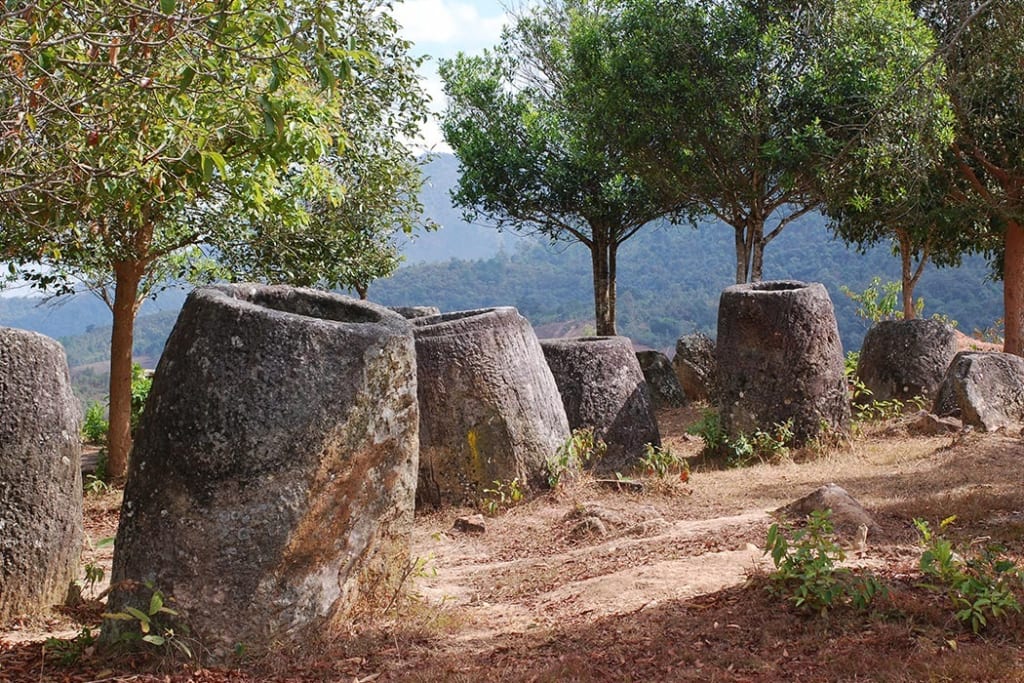"Unraveling the Enigma of the Plain of Jars".
Plain of Jars mystery.

Introduction:
Nestled within the serene landscapes of Laos, the Plain of Jars stands as a testament to an ancient mystery that has captivated archaeologists, historians, and curious minds alike. This enigmatic archaeological site, scattered with thousands of large, ancient stone jars, has sparked numerous theories and speculations about its origin, purpose, and the civilizations that once thrived in its vicinity. In this exploration, we embark on a journey to unravel the mystery of the Plain of Jars and delve into the rich tapestry of its historical significance.
The Landscape of Mystery:
The Plain of Jars is located in the Xieng Khouang Plateau in central Laos, encompassing the provinces of Xieng Khouang and Houaphan. The site is characterized by a vast, undulating landscape adorned with numerous megalithic stone jars, some standing up to three meters in height and weighing several tons. These jars, believed to be of ancient origin, are scattered across various sites within the plain.
Archaeological Discoveries:
The origins of the Plain of Jars date back to the Iron Age, with archaeological evidence suggesting that the jars were crafted between 500 BCE and 500 CE. Excavations at the site have revealed additional artifacts, including stone discs, pottery fragments, and tools, providing insights into the cultural and technological aspects of the ancient civilizations that inhabited the region.
Theories Surrounding the Purpose:
Despite decades of research and exploration, the purpose of the Plain of Jars remains a subject of debate, giving rise to various theories:
Funerary Practices: One prevalent hypothesis suggests that the stone jars served as burial vessels for the deceased. Archaeologists have discovered human remains, burial goods, and evidence of cremation at some jar sites, supporting the idea that the Plain of Jars was a burial ground.
Ceremonial and Ritualistic Functions: Another theory proposes that the jars were employed for ceremonial or ritualistic purposes. Some jars feature carvings of human figures, animals, and geometric designs, hinting at potential symbolic or religious significance.
Storage of Food or Water: Some researchers speculate that the jars were used for practical purposes, such as storing food, water, or other commodities. However, the sheer size and weight of certain jars raise questions about their feasibility for such utilitarian functions.
Ancient Brewing Industry: An unconventional theory suggests that the Plain of Jars was an ancient brewing site for rice wine. The large jars could have been utilized for the fermentation and storage of alcoholic beverages, reflecting a cultural or economic aspect of the ancient civilization.
Challenges and Preservation Efforts:
The Plain of Jars faces challenges related to its preservation and protection. The region witnessed extensive bombing during the Vietnam War, resulting in landmines and unexploded ordnance that posed risks to both archaeological efforts and local communities. Efforts to clear the area of unexploded munitions are ongoing to ensure the safety of researchers and visitors.
Cultural Heritage and Tourism:
Recognizing the cultural and historical significance of the Plain of Jars, preservation initiatives, and tourism developments aim to showcase this mysterious site while ensuring its long-term protection. UNESCO has designated the Plain of Jars as a World Heritage Site, drawing attention to its importance on the global stage.
Tourists are now able to visit the site, exploring the enigmatic landscape and gaining insights into the efforts to unravel the mysteries that lie beneath the ancient stones. Local communities also play a vital role in the sustainable development of tourism around the Plain of Jars, contributing to the preservation of their cultural heritage.
Conclusion:
The Plain of Jars continues to be an archaeological enigma, inviting explorers and scholars to unlock its secrets and illuminate the lives of the ancient civilizations that once inhabited this intriguing landscape. As ongoing research and conservation efforts shed light on the purpose and cultural significance of the stone jars, the Plain of Jars stands as a symbol of the enduring mysteries that still captivate our imaginations, bridging the gap between the past and the present. This ancient site serves as a reminder of the rich tapestry of human history waiting to be unveiled, one stone jar at a time.





Comments (1)
Hello Fatima, AI is permitted on Vocal but it is a Vocal policy that content created with AI is mentioned at the start of the story/article. Your article/story has many telltales of AI-generated content. If you don’t correct this the content may be removed by Vocal and/or you may be banned from the Vocal.